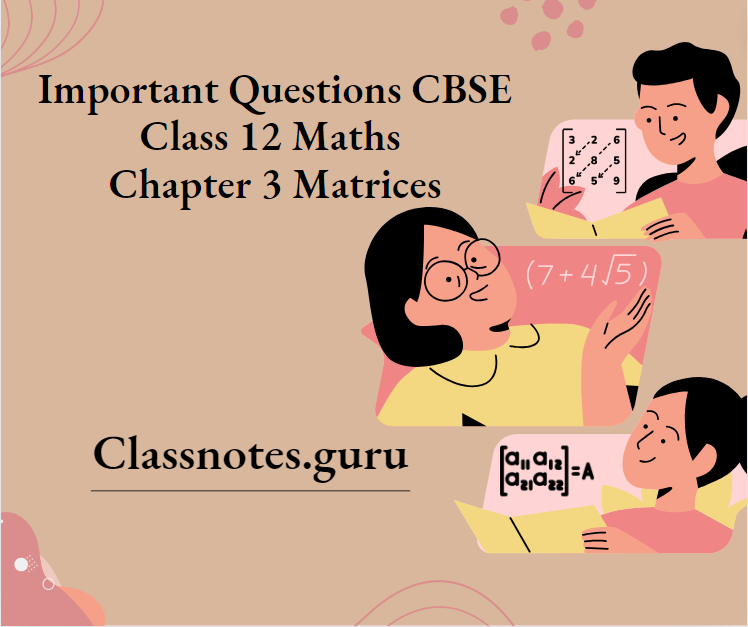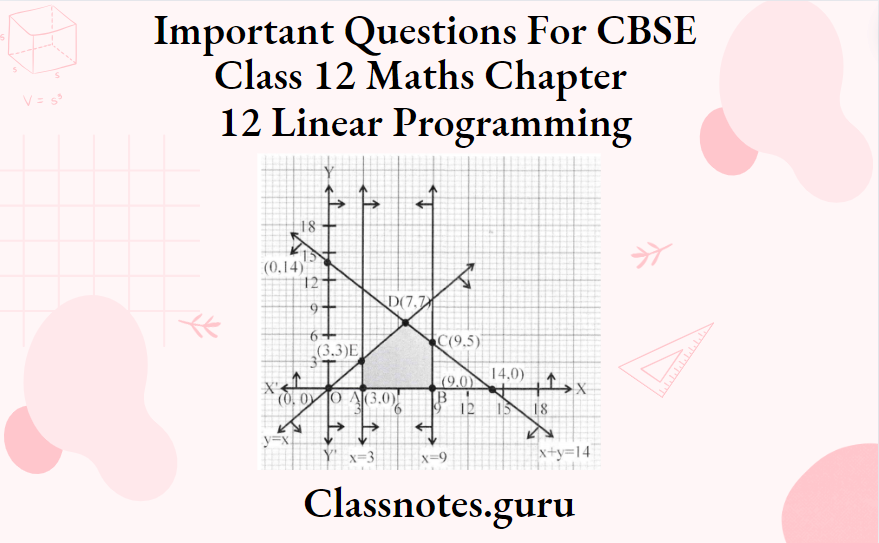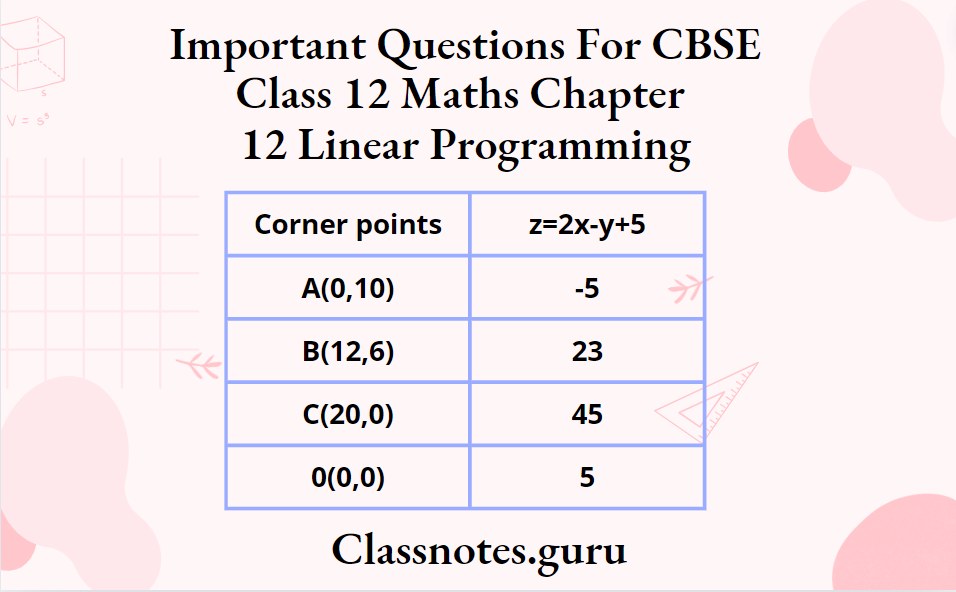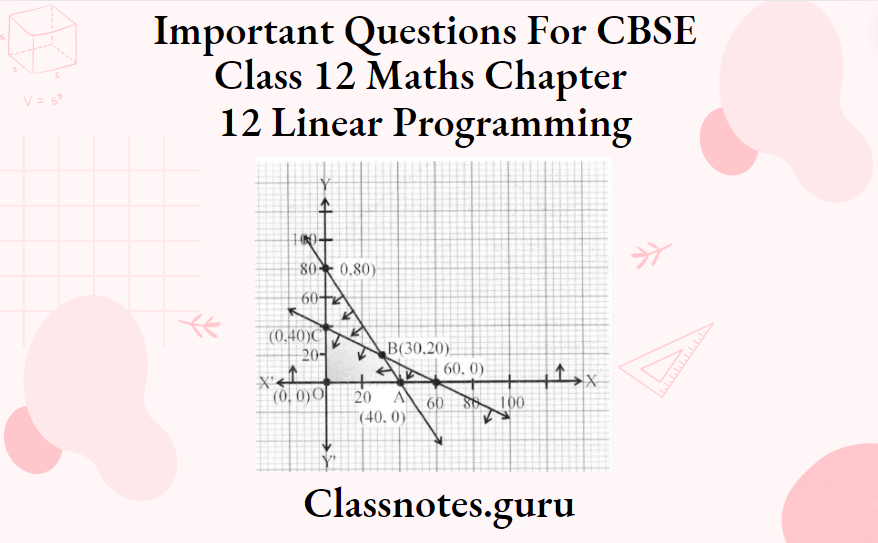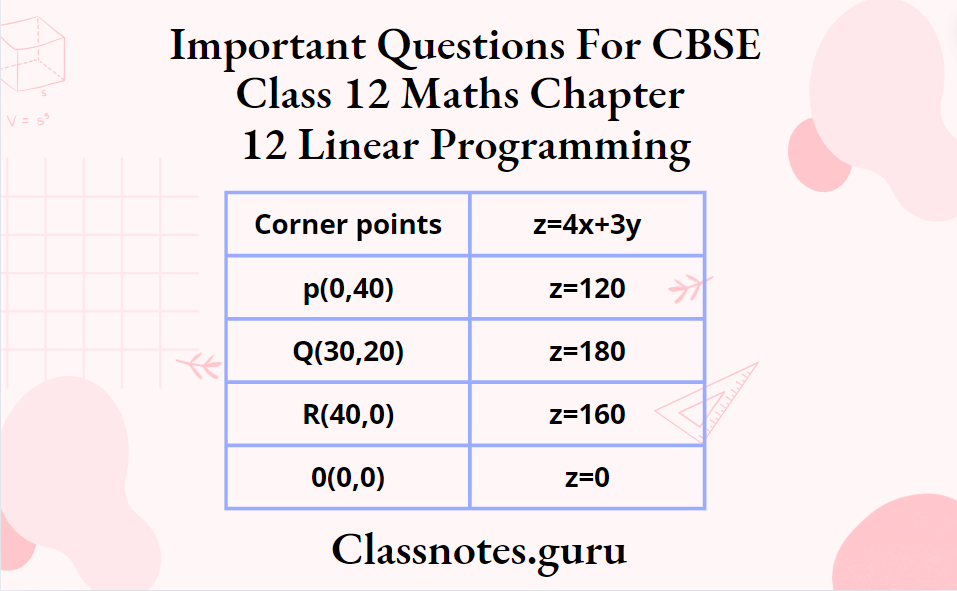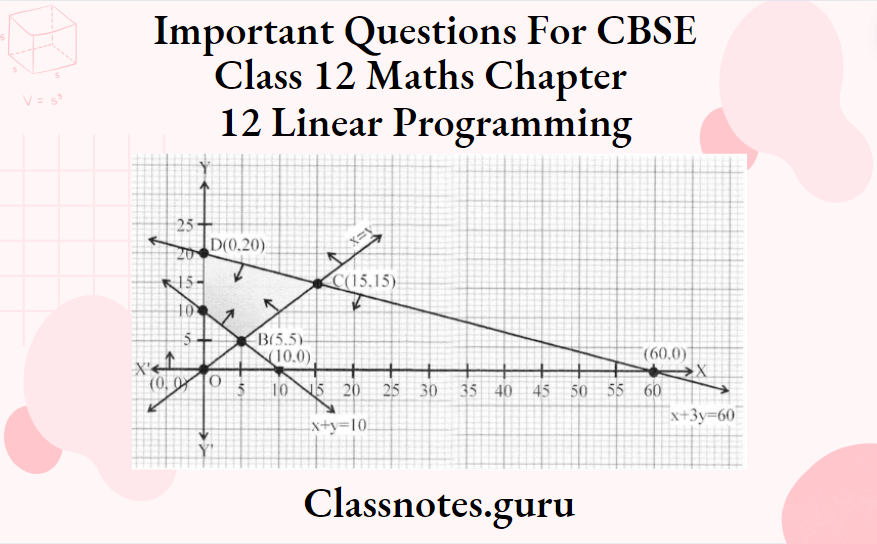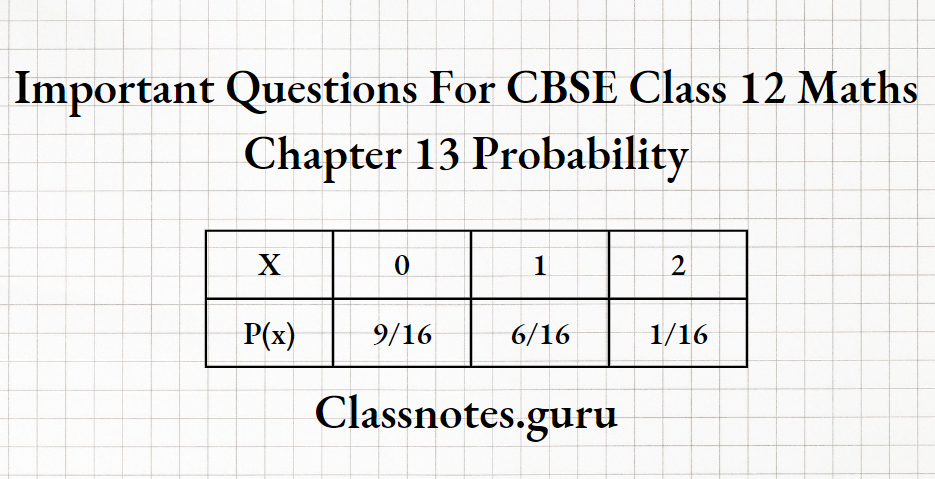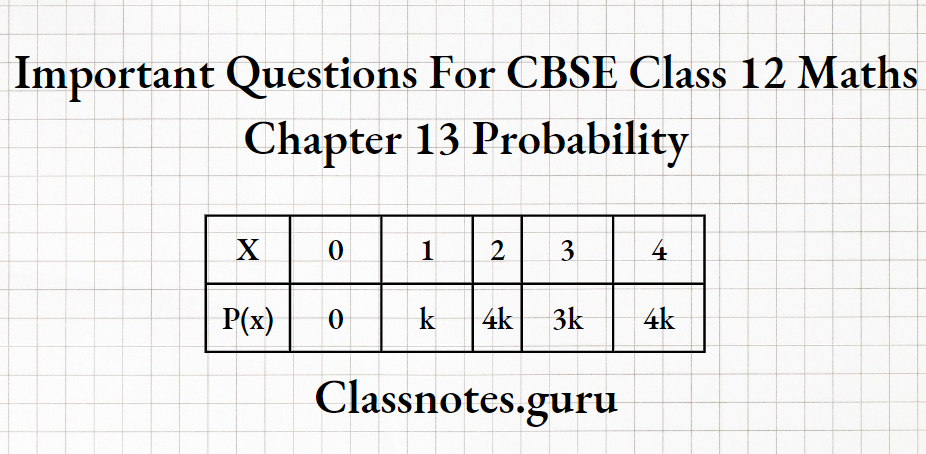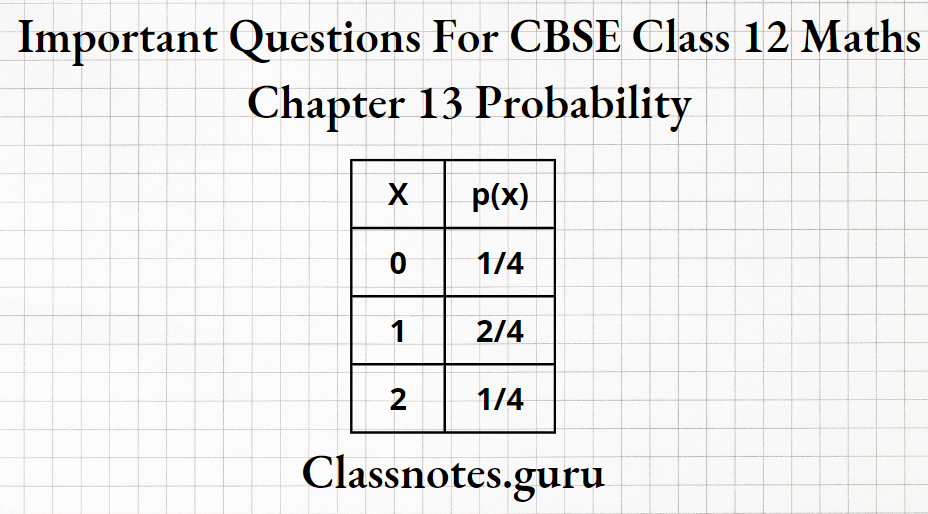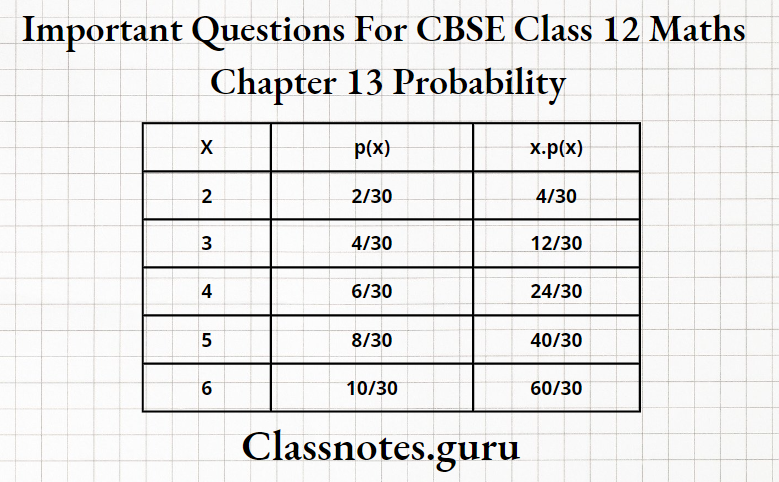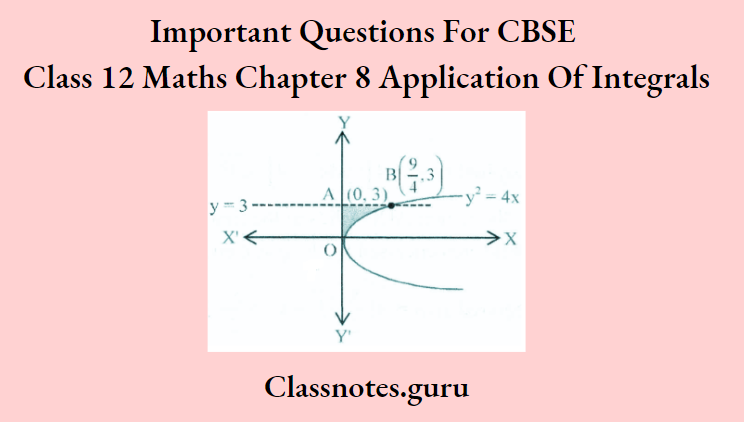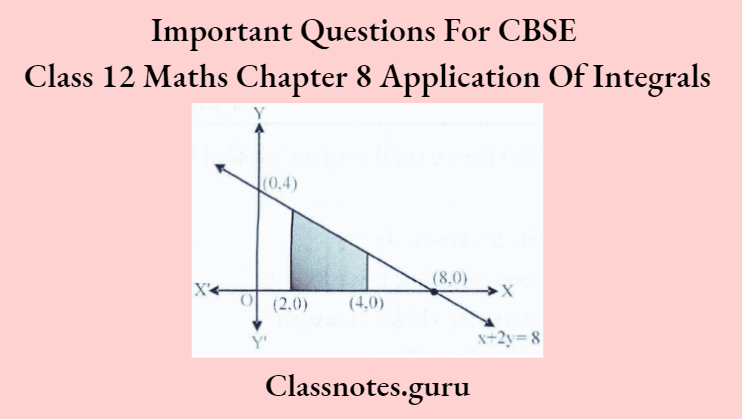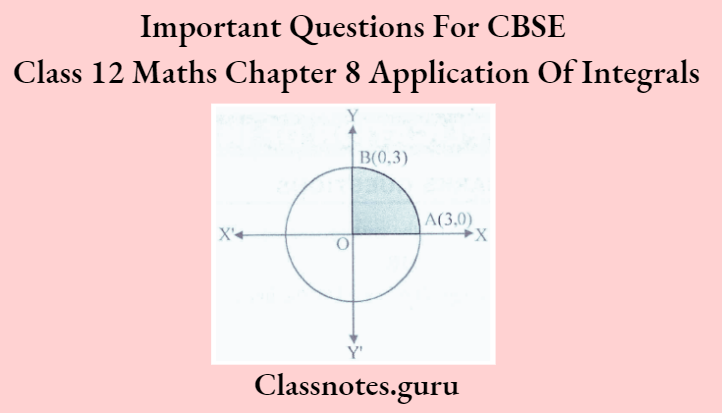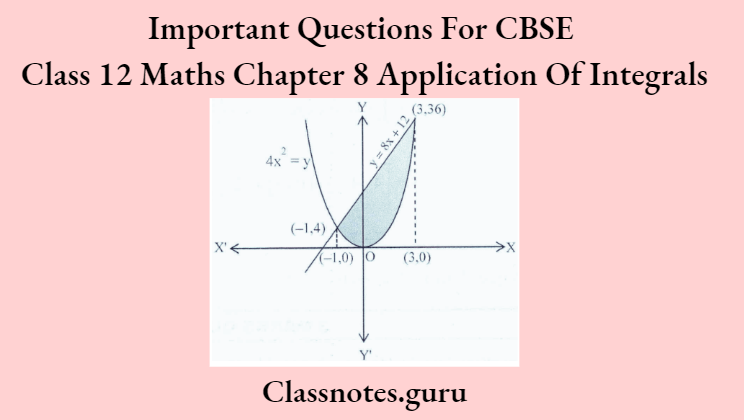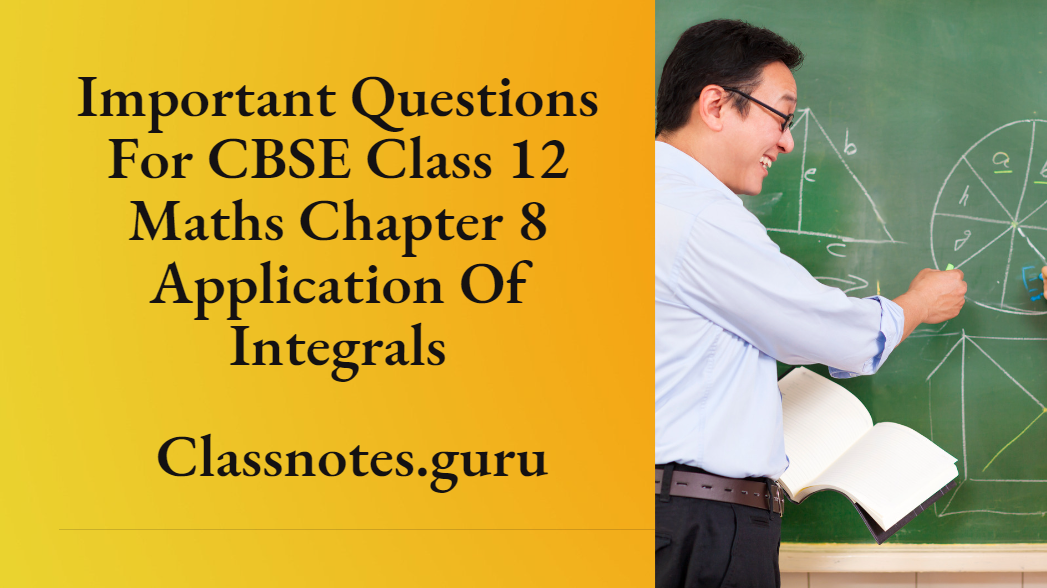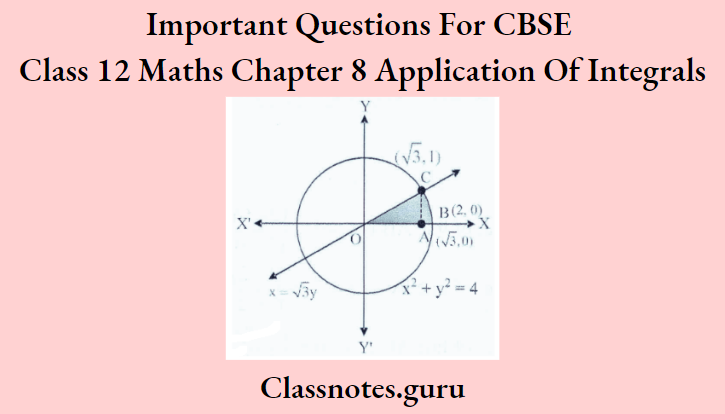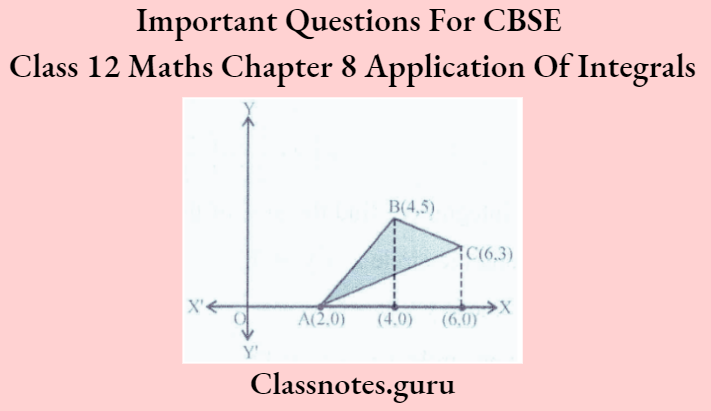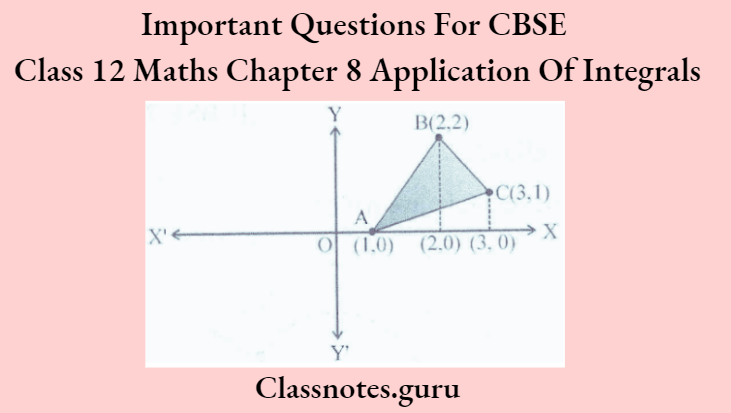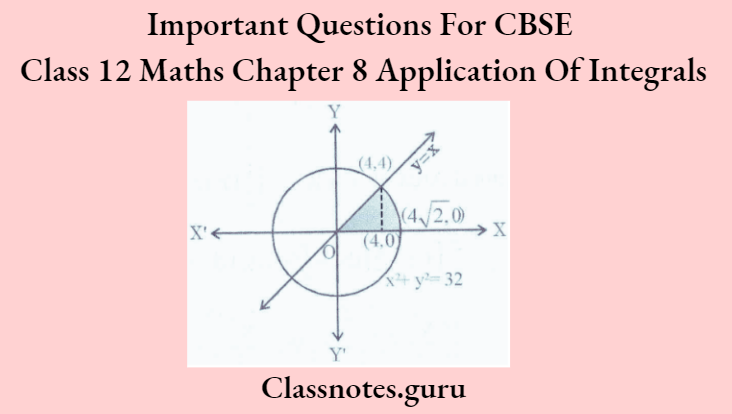CBSE Class 12 Maths Chapter 4 Determinates Important Questions
Question 1. Three points P(2x, x + 3), Q(0, x) and R(x + 3, x + 6) are eollinear. then x is equal to
- 0
- 2
- 3
- 1
Solution: 4. 1
As per the given condition \(\left|\begin{array}{ccc}
2 x & x+3 & 1 \\
0 & x & 1 \\
x+3 & x+6 & 1
\end{array}\right|=0\)
[ar(ΔPQR) = 0]
⇒ 2x (x – x – 6) — 0(x + 3 – x — 6) + (x + 3) {x + 3 – x} =0
or -12x + 3x + 9 = 0 => -9x = -9 => x = 1
Read and Learn More CBSE Class 12 Maths Important Question and Answers
Question 2. If Cij denotes the cofactor of element pij of the matrix P = \(\left[\begin{array}{ccc}
1 & -1 & 2 \\
0 & 2 & -3 \\
3 & 2 & 4
\end{array}\right]\) , then the value of C31, C23 is:
- 5
- 24
- -4
- -5
Solution: 1. 5
P = \(\left[\begin{array}{ccc}
1 & -1 & 2 \\
0 & 2 & -3 \\
3 & 2 & 4
\end{array}\right]\) (given)
⇒ C31, C23 = (3-4), {(-1)(2+3)} = 5
Determinants Class 12 Important Questions
Question 3. The system of linear equations 5x + ky = 5; 3x + 3y = 5 will be consistent if:
- k ≠ -3
- k = -5
- k = 5
- k ≠ 5
Solution: 4. k ≠ 5
The system of linear equations is given as:
5x + ky = 5 and 3x + 3y = 5
It can be written in matrix form as \(\left[\begin{array}{ll}
5 & k \\
3 & 3
\end{array}\right]\left[\begin{array}{l}
x \\
y
\end{array}\right]=\left[\begin{array}{l}
5 \\
5
\end{array}\right]\)
or A X = B
So; the given system of linear equations is consistent if |A| ≠ 0
⇒ \(\left|\begin{array}{ll}
5 & \mathrm{k} \\
3 & 3
\end{array}\right|\) 0
⇒15 – 3 k ≠ 0
⇒ k ≠ 5
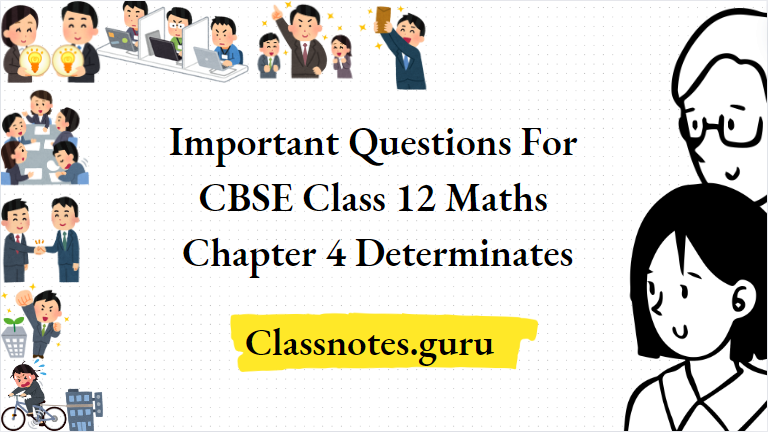
Question 4. If, for the matrix \(A=\left[\begin{array}{cc}
\alpha & -2 \\
-2 & \alpha
\end{array}\right]\),\(\left|\mathrm{A}^2\right|=125\); then the value of α is:
- 3
- -3
- 1
- 1
Solution: 1. 3
Class 12 Maths Chapter 4 Important Questions With Solutions
Given \(\left|A^3\right|=125\)
⇒ \((|A|)^3=125\)
(because \(\left|A^n\right|=|A|^n\))
⇒ \(\left(\alpha^2-4\right)^3=125\)
⇒ \(\left(\alpha^2-4\right)=5\)
⇒ \(\alpha^2=9\) or \(\alpha= \pm 3\)
Question 5. Let matrix X = [xij] is given by X = \(\left[\begin{array}{ccc}
1 & -1 & 2 \\
3 & 4 & -5 \\
2 & -1 & 3
\end{array}\right]\), Then, the matrix Y = [mij]. where mij = Minor of Xij is:
- \(\left[\begin{array}{ccc}
7 & -5 & -3 \\
19 & 1 & -11 \\
-11 & 1 & 7
\end{array}\right]\) - \(\left[\begin{array}{ccc}
7 & -19 & -11 \\
5 & -1 & -1 \\
3 & 11 & 7
\end{array}\right]\) - \(\left[\begin{array}{ccc}
7 & 19 & -11 \\
-3 & 11 & 7 \\
-5 & -1 & -1
\end{array}\right]\) - \(\left[\begin{array}{ccc}
7 & 19 & -11 \\
-1 & -1 & 1 \\
-3 & -11 & 7
\end{array}\right]\)
Solution:
X = \(\left[\begin{array}{ccc}
1 & -1 & 2 \\
3 & 4 & -5 \\
2 & -1 & 3
\end{array}\right]\)
Now, Y = [mij]
⇒ Y = \(\left[\begin{array}{lll}
m_{11} & m_{12} & m_{13} \\
m_{21} & m_{22} & m_{23} \\
m_{31} & m_{32} & m_{33}
\end{array}\right] \Rightarrow Y=\left[\begin{array}{ccc}
7 & 19 & -11 \\
-1 & -1 & 1 \\
-3 & -11 & 7
\end{array}\right]\)
Determinants Important Questions CBSE Class 12
Question 6. If x =-4 is a root of \(\left|\begin{array}{lll}
x & 2 & 3 \\
1 & x & 1 \\
3 & 2 & x
\end{array}\right|\) = 0, then the sum of the other two roots is:
- 4
- -3
- 2
- 5
Solution: 1. 4
⇒ \(\left|\begin{array}{lll}
x & 2 & 3 \\
1 & x & 1 \\
3 & 2 & x
\end{array}\right|\) = 0 (given)
⇒ \(x\left(x^2-2\right)-2(x-3)+3(2-3 x)=0\)
⇒ \(x^3-2 x-2 x+6+6-9 x=0\)
⇒ \(x^3-13 x+12=0\)
⇒ \((x+4)\left(x^2-4 x+3\right)=0\)
(because x=-4 is a root)
⇒ \((x+4)(x-1)(x-3)=0\)
Hence; the sum of other two roots = 1 + 3 = 4
Determinants Class 12 Important Questions
Question 7. The inverse of the matrix \(X=\left[\begin{array}{lll}2 & 0 & 0 \\ 0 & 3 & 0 \\ 0 & 0 & 4\end{array}\right]\)
- \(24\left[\begin{array}{ccc}1 / 2 & 0 & 0 \\ 0 & 1 / 3 & 0 \\ 0 & 0 & 1 / 4\end{array}\right]\)
- \(\frac{1}{24}\left[\begin{array}{lll}1 & 0 & 0 \\ 0 & 1 & 0 \\ 0 & 0 & 1\end{array}\right]\)
- \(\frac{1}{24}\left[\begin{array}{lll}2 & 0 & 0 \\ 0 & 3 & 0 \\ 0 & 0 & 4\end{array}\right]\)
- \(\left[\begin{array}{ccc}1 / 2 & 0 & 0 \\ 0 & 1 / 3 & 0 \\ 0 & 0 & 1 / 4\end{array}\right]\)
Solution:
Given, \(X=\left[\begin{array}{lll}2 & 0 & 0 \\ 0 & 3 & 0 \\ 0 & 0 & 4\end{array}\right]\)
|X| = \(2(12)-0+0=24 \neq 0\)
⇒ \(X^{-1}\) exists
Now, adj X = \(\left[\begin{array}{ccc}12 & 0 & 0 \\ 0 & 8 & 0 \\ 0 & 0 & 6\end{array}\right]\)
⇒ \(X^{-1}=\frac{1}{|X|} \cdot \mathrm{adj} X\)
⇒ \(X^{-1}=\frac{1}{24}\left[\begin{array}{ccc}
12 & 0 & 0 \\
0 & 8 & 0 \\
0 & 0 & 6
\end{array}\right]=\left[\begin{array}{ccc}
1 / 2 & 0 & 0 \\
0 & 1 / 3 & 0 \\
0 & 0 & 1 / 4
\end{array}\right]\)
Question 8. If A is square matrix of order 3 such that A(adj A) = \(\left[\begin{array}{ccc}-2 & 0 & 0 \\ 0 & -2 & 0 \\ 0 & 0 & -2\end{array}\right]\), then find |A|.
Solution:
Given, A (adj A) = \(\left[\begin{array}{ccc}-2 & 0 & 0 \\ 0 & -2 & 0 \\ 0 & 0 & -2\end{array}\right]\)
We know that A(adj A)= |A| I
Now, A(adj A)= \(-2\left[\begin{array}{lll}1 & 0 & 0 \\ 0 & 1 & 0 \\ 0 & 0 & 1\end{array}\right] = -2I = |A| I\)
⇒ |A|=-2
CBSE Class 12 Maths Chapter 4 Extra Questions
Question 9. If A is a non-singular square matrix of order 3 such that A² = 3A, then the value of |A| is?
- -3
- 3
- 9
- 27
Solution:
Given, A² = 3A, |A| ≠ 0, order of A is 3
∴ |A²| = |3A|
⇒ |A|²= 3³|A|
(|A²| = |A|² and |KA| = Kn|A|)
or |A| = 27
Question 10. If A is a square matrix satisfying A’A = I, write the value of |A|.
Solution:
A’A = I (given)
⇒ \(\left|A^{\prime} A\right|=|I|\)
⇒ \(\left|A^{\prime}\right||A|=|I| \Rightarrow|A|^2=1\) (because \(\left|A^{\prime}\right|=|A|\))
⇒ \(|A|=1 \text { or }|A|=-1\)
Question 11. Given, \(A=\left[\begin{array}{cc}2 & -3 \\ -4 & 7\end{array}\right]\), compute A-1 and show that 2A-1 = 9I – A.
Solution:
Given, \(A=\left[\begin{array}{cc}2 & -3 \\ -4 & 7\end{array}\right]\)
|A| = \(14-(12)=2 \neq 0\)
Hence, A is invertible.
adj A = \(\left[\begin{array}{ll}
7 & 3 \\
4 & 2
\end{array}\right]\)
Hence, \(A^{-1}=\frac{1}{|A|} \cdot \mathrm{adj} \cdot(\mathrm{A})\)
⇒ \(\mathrm{A}^{-1}=\frac{1}{2}\left[\begin{array}{ll}
7 & 3 \\
4 & 2
\end{array}\right] \text { or } 2 \mathrm{~A}^{-1}=\left[\begin{array}{ll}
7 & 3 \\
4 & 2
\end{array}\right]\)….(1)
Now, R.H.S. = \(9 \mathrm{I}-\mathrm{A}\)
⇒ \(9\left[\begin{array}{ll}
1 & 0 \\
0 & 1
\end{array}\right]-\left[\begin{array}{cc}
2 & -3 \\
-4 & 7
\end{array}\right]=\left[\begin{array}{cc}
9 & 0 \\
0 & 9
\end{array}\right]-\left[\begin{array}{cc}
2 & -3 \\
-4 & 7
\end{array}\right]=\left[\begin{array}{ll}
7 & 3 \\
4 & 2
\end{array}\right]=2 A^{-1}\)= L.H.S. [from (1)]
Hence proved.
Question 12. If \(A=\left[\begin{array}{ccc}
3 & 4 & 2 \\
0 & 2 & -3 \\
1 & -2 & 6
\end{array}\right]\); find A-1.
Determinants Previous Year Questions Class 12
Hence solve the following system of equations: 3x + 4y + 2z = 8; 0x + 2y + 3z = 3 and x + 2y + 6z = -2 or,
OR
If \(A^{-1}=\left[\begin{array}{ccc}3 & -1 & 1 \\ -15 & 6 & -5 \\ 5 & -2 & 2\end{array}\right]$ and $B=\left[\begin{array}{ccc}1 & 2 & -2 \\ -1 & 3 & 0 \\ 0 & -2 & 1\end{array}\right]\) find \((A B)^{-1} \text {. }\)
Solution:
Given, \(A=\left[\begin{array}{ccc}
3 & 4 & 2 \\
0 & 2 & -3 \\
1 & -2 & 6
\end{array}\right]\)
⇒ |A| = 3(12 -6)-4(0 + 3) + 2(0-2)= 18- 12-4=2*0
Hence, A-1 exists.
Now, co-factors are given as:
C11 = 6, C12 = —3, C13 = -2,
C21=-28, C22 = 16, C23= 10,
C31= -16, C32 = 9, C33 = 6
Hence adj A = \(\left[\begin{array}{ccc}6 & -3 & -2 \\ -28 & 16 & 10 \\ -16 & 9 & 6\end{array}\right]^{\mathrm{T}}=\left[\begin{array}{ccc}6 & -28 & -16 \\ -3 & 16 & 9 \\ -2 & 10 & 6\end{array}\right]\)
⇒ \(A^{-1}=\frac{1}{|A|}(\mathrm{adj} A)=\frac{1}{2}\left[\begin{array}{ccc}
6 & -28 & -16 \\
-3 & 16 & 9 \\
-2 & 10 & 6
\end{array}\right]\)….(1)
The system of linear equations is given as:
3x + 4y + 2z = 8
0x + 2y —3 = 3
x – 2y + 6z = -2
This system is written in matrix form as
⇒ \(\left[\begin{array}{ccc}
3 & 4 & 2 \\
0 & 2 & -3 \\
1 & -2 & 6
\end{array}\right]\left[\begin{array}{l}
x \\
y \\
z
\end{array}\right]=\left[\begin{array}{r}
8 \\
3 \\
-2
\end{array}\right]\)
⇒ AX = B
⇒ X = \(A^{-1} \cdot B\)
⇒ X = \(\frac{1}{2}\left[\begin{array}{ccc}
6 & -28 & -16 \\
-3 & 16 & 9 \\
-2 & 10 & 6
\end{array}\right] \cdot\left[\begin{array}{l}
8 \\
3 \\
-2
\end{array}\right]=\frac{1}{2}\left[\begin{array}{l}
48-84+32 \\
-24+48-18 \\
-16+30-12
\end{array}\right]\)
[from (1) and (2)]
⇒ \(\left[\begin{array}{l}
x \\
y \\
z
\end{array}\right]=\frac{1}{2}\left[\begin{array}{r}
-4 \\
6 \\
2
\end{array}\right]\)
x=-2, y=3, z=1
Or
Given, \(A^{-1}=\left[\begin{array}{ccc}3 & -1 & 1 \\ -15 & 6 & -5 \\ 5 & -2 & 2\end{array}\right]\)…(1)
and \(B=\left[\begin{array}{ccc}1 & 2 & -2 \\ -1 & 3 & 0 \\ 0 & -2 & 1\end{array}\right]\)
|B| = 1 (3 – 0) – 2(- 1 – 0) – 2(2 – 0) = 3 + 2 – 4 = 1 ≠ 0
Now, the co-factors of matrix B are given as
⇒ \(C_{11}=3, C_{12}=1, C_{13}=2\)
⇒ \(C_{21}=2, C_{22}=1, C_{23}=2,\)
⇒ \(C_{31}=6, C_{32}=2, C_{33}=5\)
∴ (adj)(B) = \(\left[\begin{array}{lll}
3 & 1 & 2 \\
2 & 1 & 2 \\
6 & 2 & 5
\end{array}\right]^1=\left[\begin{array}{lll}
3 & 2 & 6 \\
1 & 1 & 2 \\
2 & 2 & 5
\end{array}\right]\)
⇒ \(B^{-1}=\frac{1}{|B|}(\mathrm{adj} B)=\left[\begin{array}{lll}
3 & 2 & 6 \\
1 & 1 & 2 \\
2 & 2 & 5
\end{array}\right]\)….(2)
∴ (AB)-1 = B-1 A-1
= \(\left[\begin{array}{lll}
3 & 2 & 6 \\
1 & 1 & 2 \\
2 & 2 & 5
\end{array}\right] \cdot\left[\begin{array}{ccc}
3 & -1 & 1 \\
-15 & 6 & -5 \\
5 & -2 & 2
\end{array}\right]\)
=\(\left[\begin{array}{ccc}
9-30+30 & -3+12-12 & 3-10+12 \\
3-15+10 & -1+6-4 & 1-5+4 \\
6-30+25 & -2+12-10 & 2-10+10
\end{array}\right]\)
⇒ \((A B)^{-1}=\left[\begin{array}{ccc}
9 & -3 & 5 \\
-2 & 1 & 0 \\
1 & 0 & 2
\end{array}\right]\)
(from (1) and (2))
⇒ \((\mathrm{AB})^{-1}=\left[\begin{array}{ccc}
9 & -3 & 5 \\
-2 & 1 & 0 \\
1 & 0 & 2
\end{array}\right]\)
Question 13. If \(A=\left[\begin{array}{ccc}5 & -1 & 4 \\ 2 & 3 & 5 \\ 5 & -2 & 6\end{array}\right]\), find A-1 and use it to solve the following system of equations.
5x – y + 4z = 5
2x + 3y + 5z = 2
5x – 2y + 6z = -1
Solution:
Given, \(A=\left[\begin{array}{ccc}5 & -1 & 4 \\ 2 & 3 & 5 \\ 5 & -2 & 6\end{array}\right]\)
∴ |A| = \(\left|\begin{array}{ccc}
5 & -1 & 4 \\
2 & 3 & 5 \\
5 & -2 & 6
\end{array}\right|\) = 5(18+10) + (12 – 25) + 4 (-4 – 15)= 140 – 13 – 76 = 51 ≠ 0.
Hence: A-1 exists
Now co-factors of elements of A are:
⇒ \(A_{11}=28, A_{12}=13, A_{13}=-19\)
⇒ \(A_{21}=-2, A_{22}=10, A_{23}=5\)
⇒ \(A_{31}=-17, A_{32}=-17, A_{33}=17\)
∴ adj A = \(\left[\begin{array}{ccc}
28 & 13 & -19 \\
-2 & 10 & 5 \\
-17 & -17 & 17
\end{array}\right]^{\mathrm{T}}=\left[\begin{array}{ccc}
28 & -2 & -17 \\
13 & 10 & -17 \\
-19 & 5 & 17
\end{array}\right]\)
⇒ \(A^{-1}=\frac{1}{|A|}(\mathrm{adj} A)=\frac{1}{51}\left[\begin{array}{ccc}
28 & -2 & -17 \\
13 & 10 & -17 \\
-19 & 5 & 17
\end{array}\right]\)
Given system of equations are
5x – y + 4z = 5
2x + 3y + 5z = 2
5x – 2y + 6z = -1
This system is written in matrix form as
⇒ \({\left[\begin{array}{ccc}
5 & -1 & 4 \\
2 & 3 & 5 \\
5 & -2 & 6
\end{array}\right]\left[\begin{array}{l}
x \\
y \\
z
\end{array}\right]=\left[\begin{array}{r}
5 \\
2 \\
-1
\end{array}\right] }\)
⇒ AX = B ⇒ X=\(A^{-1}\) B
⇒ \({\left[\begin{array}{l}
x \\
y \\
z
\end{array}\right]=\frac{1}{51}\left[\begin{array}{ccc}
28 & -2 & -17 \\
13 & 10 & -17 \\
-19 & 5 & 17
\end{array}\right]\left[\begin{array}{r}
5 \\
2 \\
-1
\end{array}\right]}\)
or \(\left[\begin{array}{l}
x \\
y \\
z
\end{array}\right]=\frac{1}{51}\left[\begin{array}{l}
140-4+17 \\
65+20+17 \\
-95+10-17
\end{array}\right]\)
⇒ \(\left[\begin{array}{l}
x \\
y \\
z
\end{array}\right]=\frac{1}{51}\left[\begin{array}{r}
153 \\
102 \\
-102
\end{array}\right]=\left[\begin{array}{r}
3 \\
2 \\
-2
\end{array}\right]\)
⇒ x= 3, y = 2, z = -2
Question 14. Show that, for matrix A = \(\left[\begin{array}{ccc}
1 & 1 & 1 \\
1 & 2 & -3 \\
2 & -1 & 3
\end{array}\right]\), A³-6 A²+5 A+11 I=O, Hence, find \(A^{-1}\).
Or,
Using the matrix method, solve the following system of equations:
3x – 2y + 3z = 8
2x + y – z = 1
4x – 3y + 2z = 4
Important Question for Class 12 Maths Chapter 4
Solution:
Given A = \(\left[\begin{array}{ccc}
1 & 1 & 1 \\
1 & 2 & -3 \\
2 & -1 & 3
\end{array}\right]\)
To prove: A³ – 6A² + 5A + 11 I = O
⇒ \(A^2=A \cdot A=\left[\begin{array}{rrr}
1 & 1 & 1 \\
1 & 2 & -3 \\
2 & -1 & 3
\end{array}\right] \cdot\left[\begin{array}{rrr}
1 & 1 & 1 \\
1 & 2 & -3 \\
2 & -1 & 3
\end{array}\right]=\left[\begin{array}{ccc}
1+1+2 & 1+2-1 & 1-3+3 \\
1+2-6 & 1+4+3 & 1-6-9 \\
2-1+6 & 2-2-3 & 2+3+9
\end{array}\right]\)
⇒ \(A^2=\left[\begin{array}{rrr}
4 & 2 & 1 \\
-3 & 8 & -14 \\
7 & -3 & 14
\end{array}\right]\)
and \(A^3= A^2 \cdot A=\left[\begin{array}{rrr}
4 & 2 & 1 \\
-3 & 8 & -14 \\
7 & -3 & 14
\end{array}\right] \cdot\left[\begin{array}{rrr}
1 & 1 & 1 \\
1 & 2 & -3 \\
2 & -1 & 3
\end{array}\right]\)
–\(\left[\begin{array}{rrr}
4+2+2 & 4+4-1 & 4-6+3 \\
-3+8-28 & -3+16+14 & -3-24-42 \\
7-3+28 & 7-6-14 & 7+9+42
\end{array}\right]\)
⇒ \(A³=\left[\begin{array}{ccc}
8 & 7 & 1 \\
-23 & 27 & -69 \\
32 & -13 & 58
\end{array}\right]\)
L.H.S. = \(A^3-6 A^2+5 A+11I\)
= \(\left[\begin{array}{ccc}
8 & 7 & 1 \\
-23 & 27 & -69 \\
32 & -13 & 58
\end{array}\right]-6\left[\begin{array}{ccc}
4 & 2 & 1 \\
-3 & 8 & -14 \\
7 & -3 & 14
\end{array}\right]+5\left[\begin{array}{ccc}
1 & 1 & 1 \\
1 & 2 & -3 \\
2 & -1 & 3
\end{array}\right]+11\left[\begin{array}{lll}
1 & 0 & 0 \\
0 & 1 & 0 \\
0 & 0 & 1
\end{array}\right]\)
= \(\left[\begin{array}{ccc}
8-24+5+11 & 7-12+5+0 & 1-6+5+0 \\
-23+18+5+0 & 27-48+10+11 & -69+84-15+0 \\
32-42+10+0 & -13+18-5+0 & 58-84+15+11
\end{array}\right]\)
= \(\left[\begin{array}{lll}
0 & 0 & 0 \\
0 & 0 & 0 \\
0 & 0 & 0
\end{array}\right]=\mathrm{O}\) Zero matrix
Now, A³-6A²+5A+11 I = O
A³A-1 – 6A²A -1+ 5AA-1 + 11 I A-1 = OA-1 (Post multiplying both sides by \(A^{-1}\)
A²(AA-1)-6A(AA-1)+5(AA-1)+11 I A-1 = OA-1
A²-6A +5I + 11A-1 = O
because AA-1=I and OA-1 =O
⇒ \(A^{-1}=\frac{-1}{11} \cdot\left(A^2-6 A+5I\right)=\frac{-1}{11}\left\{\left[\begin{array}{ccc}
4 & 2 & 1 \\
-3 & 8 & -14 \\
7 & -3 & 14
\end{array}\right]-6\left[\begin{array}{ccc}
1 & 1 & 1 \\
1 & 2 & -3 \\
2 & -1 & 3
\end{array}\right]+5\left[\begin{array}{lll}
1 & 0 & 0 \\
0 & 1 & 0 \\
0 & 0 & 1
\end{array}\right]\right\}\)
⇒ \(A^{-1}=\frac{-1}{11}\left[\begin{array}{ccc}
4-6+5 & 2-6+0 & 1-6+0 \\
-3-6+0 & 8-12+5 & -14+18+0 \\
7-12+0 & -3+6+0 & 14-18+5
\end{array}\right]\)
⇒ \(A^{-1}=\left[\begin{array}{ccc}
-3 / 11 & 4 / 11 & 5 / 11 \\
9 / 11 & -1 / 11 & -4 / 11 \\
5 / 11 & -3 / 11 & -1 / 11
\end{array}\right]\)
The given system of equations are:
3x -2y + 3 z = 8
2x + y – z = 1 and
4x – 3y + 2z = 4
Determinants Class 12 Questions With Answers
By using the matrix method; the given system of equations can be written as; AX = B
where \(A=\left[\begin{array}{ccc}3 & -2 & 3 \\ 2 & 1 & -1 \\ 4 & -3 & 2\end{array}\right], X=\left[\begin{array}{l}x \\ y \\ z\end{array}\right]\) and \(B=\left[\begin{array}{l}8 \\ 1 \\ 4\end{array}\right]\)
Now; \(|A|=\left|\begin{array}{ccc}3 & -2 & 3 \\ 2 & 1 & -1 \\ 4 & -3 & 2\end{array}\right|\)=-3+16-30=-17 ≠0
Hence; \(\mathrm{A}^{-1}\) exists.
Now; \(A=\left[\begin{array}{ccc}3 & -2 & 3 \\ 2 & 1 & -1 \\ 4 & -3 & 2\end{array}\right]\)
Co-factors are given as: \(C_{11}=-1, \quad C_{12}=-8, C_{13}=-10, C_{21}=-5, C_{22}=-6, C_{23}=1, C_{31}=-1, C_{32}=9, C_{33}=7\)
Hence, (adj)(A)= \(\left[C_{i j}\right]^{\mathrm{T}}\)
adj(A)= \(\left[\begin{array}{ccc}
-1 & -5 & -1 \\
-8 & -6 & 9 \\
-10 & 1 & 7
\end{array}\right]\)
Now; AX = \(B \Rightarrow X=A^{-1} \cdot B\) = \(\frac{\mathrm{adj} A}{|A|} \cdot B\)
⇒ \(\left[\begin{array}{l}
x \\
y \\
z
\end{array}\right]=-\frac{1}{17}\left[\begin{array}{ccc}
-1 & -5 & -1 \\
-8 & -6 & 9 \\
-10 & 1 & 7
\end{array}\right] \cdot\left[\begin{array}{l}
8 \\
1 \\
4
\end{array}\right]=-\frac{1}{17}\left[\begin{array}{c}
-8-5-4 \\
-64-6+36 \\
-80+1+28
\end{array}\right]=-\frac{1}{17}\left[\begin{array}{l}
-17 \\
-34 \\
-51
\end{array}\right]\)
⇒ \(\left[\begin{array}{l}
x \\
y \\
z
\end{array}\right]=\left[\begin{array}{l}
1 \\
2 \\
3
\end{array}\right]\)
x=1, y=2, z=3
Question 15. If \(A=\left[\begin{array}{ccc}
2 & -3 & 5 \\
3 & 2 & -4 \\
1 & 1 & -2
\end{array}\right]\), find A-1. Hence, using A-1, solve the system of equations:
2x – 3y + 5z = 11,
3x + 2y – 4z = -5,
x + y -2z = -3.
Solution:
Given, \(A=\left[\begin{array}{ccc}
2 & -3 & 5 \\
3 & 2 & -4 \\
1 & 1 & -2
\end{array}\right]\)
A is invertible if |A| ≠ 0
Now. |A| = 2(-4 + 4) + 3 (-6 + 4) + 5(3 – 2)= 0 – 6 + 5 =-1≠0
Co-factors are given as :
⇒ \(C_{11}=0, C_{12}=2, C_{13}=1\)
⇒ \(C_{21}=-1, C_{22}=-9, C_{23}=-5\)
⇒ \(C_{31}=2, C_{32}=23, C_{33}=13\)
⇒ (adj) \((\mathrm{A})=\left[\mathrm{C}_{1 \mathrm{ij}}\right]^{\mathrm{T}}\)
or (adj) \((\mathrm{A})=\left[\begin{array}{ccc}
0 & 2 & 1 \\
-1 & -9 & -5 \\
2 & 23 & 13
\end{array}\right]^{\mathrm{T}}=\left[\begin{array}{ccc}
0 & -1 & 2 \\
2 & -9 & 23 \\
1 & -5 & 13
\end{array}\right]\)
⇒ \(\mathrm{A}^{-1}=\frac{\mathrm{adj}(\mathrm{A})}{|\mathrm{A}|}=\left[\begin{array}{ccc}
0 & 1 & -2 \\
-2 & 9 & -23 \\
-1 & 5 & -13
\end{array}\right]\)
Now, given equations are 2x-3y + 5z = 11; 3x + 2y -4z = -5 and x + y – 2z = -3
⇒ \({\left[\begin{array}{ccc}
2 & -3 & 5 \\
3 & 2 & -4 \\
1 & 1 & -2
\end{array}\right]\left[\begin{array}{l}
\mathrm{x} \\
\mathrm{y} \\
\mathrm{z}
\end{array}\right]=\left[\begin{array}{l}
11 \\
-5 \\
-3
\end{array}\right]}\)
⇒ \(\mathrm{AX}=\mathrm{B} \text { or } \mathrm{X}=\mathrm{A}^{-1} \mathrm{~B} \\
\Rightarrow \mathrm{X}=\left[\begin{array}{ccc}
0 & 1 & -2 \\
-2 & 9 & -23 \\
-1 & 5 & -13
\end{array}\right]\left[\begin{array}{l}
11 \\
-5 \\
-3
\end{array}\right]\)
or \(\mathrm{X}=\left[\begin{array}{c}
0 \times 11+(1) \times(-5)+(-2) \times(-3) \\
(-2) \times 11+9 \times(-5)+(-23) \times(-3) \\
(-1) \times 11+5 \times(-5)+(-13) \times(-3)
\end{array}\right] \\
\Rightarrow \quad\left[\begin{array}{l}
\mathrm{x} \\
\mathrm{y} \\
\mathrm{z}
\end{array}\right]=\left[\begin{array}{l}
1 \\
2 \\
3
\end{array}\right]\)
⇒ \(\mathrm{x}=1, \mathrm{y}=2, \mathrm{z}=3\)

